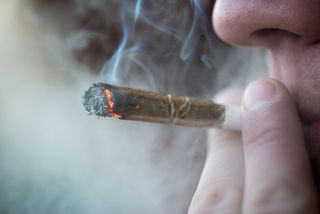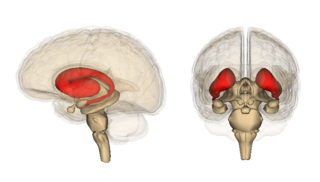Dopamine
Heavy Marijuana Use May Reduce Your Brain's Dopamine Release
Cannabis use disorders are linked with low levels of dopamine in the striatum.
Posted April 15, 2016 Reviewed by Ekua Hagan

As a teenager in the early 1980s, I smoked a ton of marijuana and spent most of my early high school years stoned out of my mind. It was a very troubling time for me. During my adolescence, I struggled with a wide range of personal and family issues. At the time, I felt trapped, bullied, and totally alone at a stodgy prep school in Wallingford, Connecticut.
Cannabis was a way for me to escape by making me feel "comfortably numb." When I was 16 years old, I got high every day and listened to The Wall incessantly. That Pink Floyd song was my anthem.
In many ways, I deluded myself that I was transcending the reality of my life by doing bong hits. But ultimately, being numb made me feel jaded, empty, and a hollowed-out type of dysphoria. By the time I hit rock bottom, I already felt so dead inside that suicide seemed like the easiest, and most viable, permanent exit plan.
Eventually, a terrifying "bad trip" on psilocybin—which brought the mind-altering scariness of using hard drugs to life in vivid technicolor—rattled me to the core. Having a bad trip triggered a "volition switch" to go off in my brain that made me want to stop abusing drugs on a visceral level.
Luckily, I discovered the brain benefits of running when I was 17, and it turned my life around. I describe the metamorphosis that led me to stop using drugs on p. 7 of The Athlete’s Way,
“I was only seventeen but felt as if I’d been dragged around the block a few times. I had. I knew I never wanted that razor-blade feeling in my mouth again. I never wanted to be comfortably numb. That was a turning point for me. I haven’t done drugs since.
In many ways, I was probably self-medicating for a tendency towards depression, and some chemical imbalances in my brain. I medicate with exercise now. I am vigilant about my mental health and don’t take it for granted. The endocannabinoids [your body's self-made cannabis], dopamine, epinephrine, and opioids that I pump through my system now make my life force stronger and more resilient. I try the best I can not to be self-destructive and not to fear success. I refuse to sabotage my life in any way.”
Cannabis Use Disorders May Reduce Dopamine Levels in the Striatum

As a teenager, I realized that if I used an exogenous substance (drugs) to hijack the brain receptors of any naturally produced neurochemicals, that, over time, my ability to feel joyful without the use of drugs became impossible. I have a hunch that one reason I got hooked on cannabis was that my brain was no longer able to produce sufficient endocannabinoids, which are strongly linked to "runner's high."
Because of my own struggles with cannabis use disorder (CUD) as a teenager, I always have my antennae up for any scientific research that deconstructs what happens in the brain when someone smokes copious amounts of weed. This morning, I read about a recent study which helps to explain what might be going on in terms of specific brain regions and the dopamine system for people with CUD.
The March 2016 study, “Deficits in Striatal Dopamine Release in Cannabis Dependence," was published in Molecular Psychiatry. For this study, an international team of researchers used positron emission tomography (PET) brain scans to track a radiolabelled molecule that binds to dopamine receptors in the brain. The scientists specifically measured dopamine release in the striatum and its subregions.

The brain scans identified that severe marijuana dependence (now referred to as cannabis use disorder) is associated with a reduced release of dopamine within the striatum. The striatum is a brain region involved in working memory, impulsive behavior, and attention.
The researchers believe that lower dopamine release within the striatum may be linked to the greater emotional withdrawal and inattention observed in marijuana-dependent study participants. Previous studies have found that addiction to other drugs, such as cocaine and heroin, have similar effects on dopamine release. However, this is the first study to provide evidence that heavy cannabis use may reduce dopamine release.
In the brain, dopamine functions as a neurotransmitter which helps control the brain's pleasure and reward centers. Dopaminergic pathways are neural pathways that transmit dopamine from one region of the brain to another. Dopamine drives reward-motivated behavior and helps us regulate movement and emotional responses.
Dopamine not only enables someone to identify rewards, but it gives him or her the oomph to seize the day and achieve goals. People with low levels of dopamine are statistically more prone to drug abuse, addiction, and amotivational syndrome.
In the most recent study, the cannabis users had significantly lower dopamine release in the striatum, including subregions involved in associative and sensorimotor learning. The researchers also explored the relationship between dopamine release in key areas of the striatum and cognitive performance on learning and working memory tasks. Lower dopamine release was associated with subpar performance on both tasks.
In a statement, Anissa Abi-Dargham, M.D., professor of psychiatry (in radiology) at Columbia University Medical Center (CUMC) and a lead author of the paper said,
"We don't know whether decreased dopamine was a preexisting condition or the result of heavy cannabis use ... But the bottom line is that long-term, heavy cannabis use may impair the dopaminergic system, which could have a variety of negative effects on learning and behavior.
In light of the more widespread acceptance and use of marijuana, especially by young people, we believe it is important to look more closely at the potentially addictive effects of cannabis on key regions of the brain."
Conclusion: Heavy Cannabis Use Can Be Harmful, Particularly in Youth
In March 2016, another study reported that cannabis use disorders in the United States are rising dramatically. According to the study, the percentage of Americans who reported using marijuana in the past year doubled between 2002 and 2012. Unfortunately, only 13.2 percent of people with lifetime cannabis use disorder sought professional treatment for their addiction.
Additionally, a 2012 report from the Substance Abuse and Mental Health Services Administration on perceptions about the riskiness of cannabis found that attitudes have changed dramatically in recent years. For example, in the United States, the proportion of adolescents who perceive marijuana as risky has decreased to an all-time low of 45 percent.
As a parent and public health advocate, I feel an obligation to educate people (especially teenagers) about the risks vs. rewards of long-term heavy marijuana use and the potential consequences of persistent cannabis use on your physical, psychological, and fiscal well-being.
Discussing the potential dangers of heavy marijuana use and cannabis use disorders often triggers fierce reactions and leads to passionate debate. For the record, I do not have any strong personal opinions about the legalization of marijuana. My motivation for writing about the latest scientific research on the side-effects of heavy marijuana use is to educate readers so that every individual can make an informed personal decision about his or her marijuana use.
In a statement regarding the most recent study on heavy cannabis use and dopamine release, Jeffrey Lieberman, M.D., Chair of Psychiatry at CUMC and past president of the American Psychiatric Association, concluded, "these findings add to the growing body of research demonstrating the potentially adverse effects of cannabis, particularly in youth, at the same time that government policies and laws are increasing access and use."
To read more on this topic, check out my Psychology Today blog posts,
- "The Neurochemicals of Happiness"
- "The Upward Spiral of Healthy Behaviors and Positive Attitudes"
- "Is Runner's High Our Evolutionary Antidote to Laziness?"
© 2016 Christopher Bergland. All rights reserved.
Follow me on Twitter @ckbergland for updates on The Athlete’s Way blog posts.
The Athlete’s Way® is a registered trademark of Christopher Bergland.




